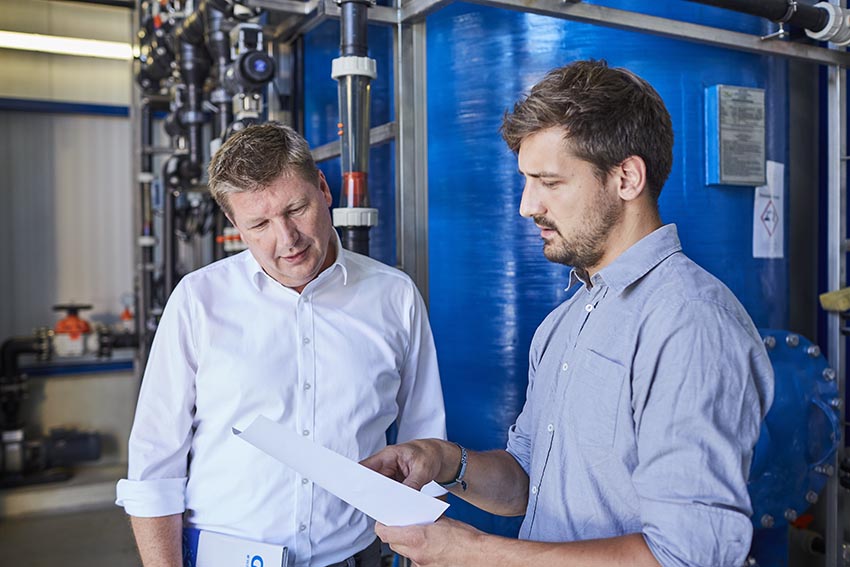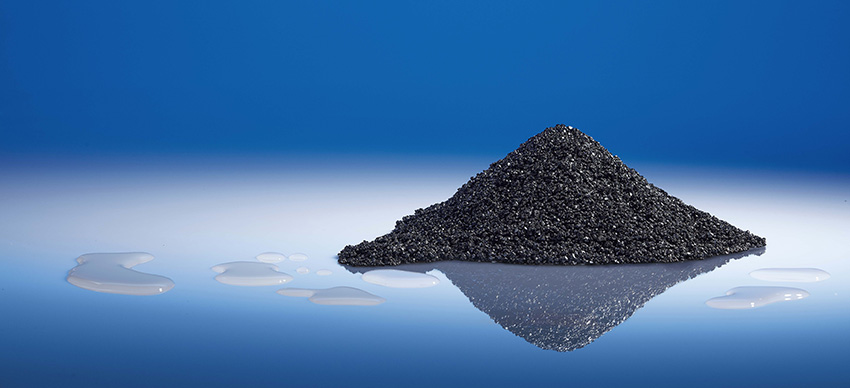GEH Wasserchemie is a german company, founded in 1997, with 16 employees. The company has its headquarter in Osnabrück, which is located in the north-west part of Germany. They are the inventor and producer of the patented adsorbent GEH®, made of granular ferric hydroxide. GEH® enables customers to remove toxic heavy metals such as vanadium or arsenic from water, while leaving the important and useful minerals untouched. This is possible by using the principle of specific adsorption.
Unlike the almost identically spelled absorption, in which a certain particle is bound to the core of an absorbent, the principle of adsorption relies on the bounding to the surface of the adsorbent. Due to the high quality creation process, the active surface of GEH® is 300 m²/g.
GEH Wasserchemie is entirely structured around trading with companies and communes. Especially the administrators and builders of water treatment plants are our main customer base.
Easy Engineering: What are the main areas of activity of the company?
GEH Wasserchemie: GEH® is being used to treat water within 61 countries so far, ranging from the United States, Argentina, France to South Korea – just to name a few. We especially focus on areas with high water contamination in regards to the toxic heavy metal arsenic. Due to arsenic being a natural occurrence within the earth’s crust, almost every country on earth contains regions, in which the drinking water is polluted by arsenic. While a very small amount of arsenic is unharmful to humans, larger doses most often lead to sickness like cancer or untimely death in the long term. This is why the World Health Organisation (WHO) set a recommendation of 10µg/L of arsenic in drinking water. While a lot of nations already set a threshold for arsenic in drinking water, there are some regions where no limit applies until today.

E.E: What’s the news about new products?
EH Wasserchemie: While our product GEH® was developed for the removal of arsenic in drinking water treatment, we are continuously developing new applications where it can pose a solution. We just gained the German approval as the first product to be used for vanadium removal in drinking water treatment.
At the moment, we are testing the effectiveness of GEH® to remove lead with very promising results so far. Application fields, beneath drinking water treatment, can be the purification of wastewater and process waters.
E.E: What are the ranges of products?
EH Wasserchemie: We at GEH Wasserchemie offer five products, which treat different types of water. We are proud of the fact, that all of our products are internationally certified with the DIN EN 15029 and NSF/ANSI Standard 61 seals of quality.
While GEH® 102 is the most commonly requested adsorbent, used to treat drinking water, there are 5 more products, that we offer to our customers. We also supply GEH® 101, GEH® 103, GEH® 104, GEH® 105, which respectively treat waste water, mineral/table water, water within the environment and precipitation.

E.E: At what stage is the market where you are currently active?
EH Wasserchemie: While it is difficult to make precise statements about the future of GEH Wasserchemie, we believe that the trend of water and especially arsenic treatment is currently in its early stages with massive potential. While there is already a substantial number of countries trying to follow the recommendations of the World Health Organization, the amount of communes, which are not yet taking enough care about arsenic in their drinking water supply is substantial. Many other countries, which turned a blind eye in the past also show tendencies to open up about (new) treatment methods.
E.E: What can you tell us about market trends?
EH Wasserchemie: We are currently experiencing an increasing awareness about heavy metals (especially arsenic) in many countries. Many countries such as Argentina even reworked their laws regarding arsenic in drinking water to make them even stricter. Some countries even go further below the recommendation of the WHO regarding arsenic in drinking water. To name an example, the US state New Hampshire already created a limit of 5 µg/L arsenic in drinking water and positions itself as an important role model for other states and countries.
In addition to that, technologies to measure arsenic and other toxins in water are continuously becoming more accurate and reliable. While we and most of our customers mainly focus on arsenic, we also notice an increasing demand for purifying their drinking water from vanadium. Now, more than ever, governments and communes are looking for a reliable and low maintenance way to clean their water from toxins. This is where our adsorbent comes into play. Due to the high reliability and low maintenance of our product, we are prepared for the current and the upcoming market trends.

E.E: What are the most innovative products marketed?
EH Wasserchemie: We believe, that the GEH® (Especially GEH® 102 due to its ability to treat drinking water, which is essential to live) itself was a groundbreaking innovation itself. Before GEH® was invented, the flocculation was the most common way to clean water from heavy metals. While this concept itself is not bad, it does have flaws. While the adsorption using GEH® only consists of one low maintenance process step and no reliance on electricity (as long, as there is a water flow), the flocculation consists of five complicated, electricity reliant and high maintenance steps to work properly. In addition to that, GEH® is cheaper and more reliable in comparison in a long run. Even now, more than 25 years after the creation of the first GEH®, we are still finding possibilities to treat other impurities in water, using our adsorbent.
E.E: What estimations do you have for 2022?
EH Wasserchemie: While it is difficult to create a precise forecast for 2022, we believe that (clean) water is rapidly gaining increasing importance and value. Reasons for this are climate change and the growth of the human population. Water is life – and if the current water sources are no longer sufficient for the human population due to the aforementioned reasons, other sources, which might have been avoided in the past due to high arsenic pollution are no longer avoidable.
In 2022, our team from GEH Wasserchemie is working on reaching out to the countries, that recently adapted an arsenic (or vanadium) limit in their drinking water. Every human has a right for clean water and we continue to do our part in achieving just that in 2022.

